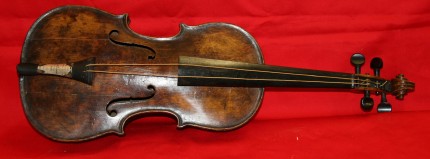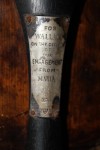
The violin played by bandmaster Wallace Hartley as Titanic sank the night of April 14th, 1912, has incredibly survived and was discovered in a North Yorkshire attic in 2006. Auction house Henry Aldridge & Son announced Friday that after years of careful research and scientific analysis, they can confirm that the violin exists and is the real deal.
 The owner, who prefers to remain anonymous, found the violin in a leather luggage case monogrammed “W. H. H.” when he was rummaging through his mother’s belongings. She was an amateur musician and a letter was found inside the case written by her former teacher, a local musician and violin instructor, who gave her this inestimable treasure. Also found inside the valise were Hartley’s silver cigarette case and a signet ring.
The owner, who prefers to remain anonymous, found the violin in a leather luggage case monogrammed “W. H. H.” when he was rummaging through his mother’s belongings. She was an amateur musician and a letter was found inside the case written by her former teacher, a local musician and violin instructor, who gave her this inestimable treasure. Also found inside the valise were Hartley’s silver cigarette case and a signet ring.
 After making this crazy find, the owner contacted Henry Aldridge & Son who specialize in Titanic memorabilia. The monogrammed case, jewelry, letter and an engraved silver plate attached to the violin’s tail piece all suggested either authenticity or an impressively elaborate hoax, but as excited as they were by the prospect of having found the most important Titanic artifact to survive the sinking, involved in one of its most iconic moments — the band playing “Nearer, My God, to Thee” while the ship went down — auction house experts realized it would take a great deal of work to authentic this miraculous survival.
After making this crazy find, the owner contacted Henry Aldridge & Son who specialize in Titanic memorabilia. The monogrammed case, jewelry, letter and an engraved silver plate attached to the violin’s tail piece all suggested either authenticity or an impressively elaborate hoax, but as excited as they were by the prospect of having found the most important Titanic artifact to survive the sinking, involved in one of its most iconic moments — the band playing “Nearer, My God, to Thee” while the ship went down — auction house experts realized it would take a great deal of work to authentic this miraculous survival.
They first brought it to the UK’s Forensic Science Service, a government office which provided forensic analysis to British police and other authorities before it was closed last year due to budget cuts. The service tested the corrosion and water stains on the violin, using other artifacts that survived the wreck for comparison, and found the corrosion deposits were “compatible with immersion in sea water.” Two long cracks on the violin’s body were determined to have been caused by moisture damage.
 Next a jewelry expert took it in hand to examine the silver plate. The plate is inscribed “For Wallace on the occasion of our engagement from Maria.” Wallace Hartley’s fiancé was named Maria Robinson; she gave him a violin when they got engaged in 1910. The expert confirmed that the plate was original to the violin, engraved contemporaneously with the 1910 hallmarks on the panel.
Next a jewelry expert took it in hand to examine the silver plate. The plate is inscribed “For Wallace on the occasion of our engagement from Maria.” Wallace Hartley’s fiancé was named Maria Robinson; she gave him a violin when they got engaged in 1910. The expert confirmed that the plate was original to the violin, engraved contemporaneously with the 1910 hallmarks on the panel.
While the physical evidence was being put to rigorous analysis, Henry Aldridge researchers and Hartley’s biographer Christian Tennyson-Ekeburg examined to the documentary record to try to trace its path from the deck of the sinking ship to the North Yorkshire attic. According to a news account, Hartley’s body was found 10 days after the disaster by a ship called the Mackay Bennett. He was fully dressed and the instrument was strapped to his body. However, the Mackay Bennett records have an inventory of the items found on the body and the violin is not listed.
 Historians have assumed that either the news account was exaggerated/fictional or that the violin was stolen by someone after the body was found, but Maria Robinson’s diary proves that the violin was recovered and officials returned it to her. Researchers found a transcript of a telegram dated July 19, 1912, in her diary. Sent to the Provincial Secretary of Nova Scotia, the telegram read: “I would be most grateful if you could convey my heartfelt thanks to all who have made possible the return of my late fiance’s violin.”
Historians have assumed that either the news account was exaggerated/fictional or that the violin was stolen by someone after the body was found, but Maria Robinson’s diary proves that the violin was recovered and officials returned it to her. Researchers found a transcript of a telegram dated July 19, 1912, in her diary. Sent to the Provincial Secretary of Nova Scotia, the telegram read: “I would be most grateful if you could convey my heartfelt thanks to all who have made possible the return of my late fiance’s violin.”
It seems that the news story got close to the truth. His violin wasn’t strapped to his body directly, but rather Hartley put his violin in his valise (which was too small for the bow to fit) and then strapped the bag around him right before the sinking. The bag and violin may have helped keep his body floating, and since he was on his back and they were on top of his life jacket on his chest, the violin and bag were for the most part not immersed in the water. A letter from his mother found in Hartley’s breast pocket survived with almost no water damage.
Hartley’s cigarette case and signet ring were returned to his father. He gave them to Maria and she kept them together with the valise and violin as a sort of shrine to her lost beloved. She never married and died of stomach cancer at her home in Bridlington, East Yorkshire, in 1939 when she was just 59. Maria’s sister Margaret gave the valise and contents to the Bridlington Salvation Army, telling its leader Major Renwick about the incredible journey the violin had taken. Major Renwick gave it to a Salvation Army member who was a violin teacher, again passing on the Titanic story. The teacher gave it to his student, the current owner’s mother, along with a letter relaying what Major Renwick had told him.
In the early 1940s, the current owner’s mother was a member of the Womens’ Auxiliary Air Force stationed at Bridlington. She met the music teacher who later dispatched the valise and violin to her.
A covering letter that has been found states: “Major Renwick thought I would be best placed to make use of the violin but I found it virtually unplayable, doubtless due to its eventful life.”
The owner plans to eventually sell this marvel, but first he wants it to be seen by as many people as possible. It will go on display at Belfast City Hall, just a mile away from where Titanic was built, at the end of the month. They’re working on putting together an international tour after that.
Amazing! Thanks once again for a great read.
This story has HOAX written all over it.
Hartley’s body was found ten days after the sinking WITHOUT a violin or case.
The “draft’ note by Maria is highly suspect- it’s written in block letters, and on a page from a April 1912 appointment book- clear sign of a clumsy fake if you ask me. There is no record in Nova Scotia of any correspondence from or to Maria R. Everything about this story is bogus. It’s amazing what greed will drive people to do.
What an amazing story! It seems there is much controversy surrounding it, even here on your blog.
Also: http://www.independent.co.uk/arts-entertainment/classical/news/authenticity-row-erupts-after-violin-played-moments-before-the-titanic-sank-is-discovered-8539588.html
The “back” story is simply not trustworthy.
Only a fool would buy this violin, and belive it is the real article.
Very interesting.
If this is a hoax it is an extremely elaborate one. Not only creating violin to appear of the appropriate age with water damage, the case, but also the signet ring and cigarette case which accompany it. Likewise knowing which jeweller’s hallmarks to use specific to 1910 for the engraved silver plate is rather impressive, especially as there are multiples of them.
Stranger things have happened which have been ascribed as impossible.
Thank you for the post along with the hi-res images.
It’s very improbable that the ring, cigarette case and other items would have remained inside the case when the case was passed from person to person as the “story” goes. I doubt Maria Robinson’s family would have simply passed everything on to the Salvation army in a single ‘donation’. The story gets off to a bad start right there.
The silver plate could easily have been cut from a circa 1910 artifact complete with hall marks- all for purpose of giving the look of authenticity. Acid- even cooked egg yolk- can artifically age silver rather quickly. The Hall marks to my eye look out of place- they detract from the inscription as they are too large and too obvious. The tarnishing looks ‘over-done’ The steel screws are highly suspicious too. The real deal would have been done with brass or nickle screws. But those steel screws rusted up nicely- and can also fool the unwary.
Believe me, “antiques” are easier to fake than most people think. This is clearly a fake in my humble opinion.
Here’s interesting example showing how easily ‘experts’ can be fooled.
http://www.thehenryford.org/exhibits/pic/2000/00apr.asp
http://en.wikipedia.org/wiki/Armand_LaMontagne
I disagree that the plate looks at all odd or overdone.
The hallmarks are fine, as is the silver plate.
Forged silver, complete with forged hall marks, is far more common than people believe. It would be naive to think otherwise. The problem has existed for hundreds of years. Don’t under-estimate the greed factor in this case. Follow links below to learn more.
“Biggest silver forger in decades brought to justice”
http://www.antiquestradegazette.com/news/2008/oct/06/biggest-silver-forger-in-decades-brought-to-justice/
“Auctioneers on alert as vendor tries to pass off fake silver”
http://www.antiquestradegazette.com/news/2005/jul/19/auctioneers-on-alert-as-vendor-tries-to-pass-off-fake-silver/
See photos of fake hall mark stamps here-
http://www.thegoldsmiths.co.uk/media/3751010/ashleyrussell.pdf
From 1899- “Spurious Marks on English Silver”
http://www.925-1000.com/a_Spurious1899.html
http://www.ba-education.com/for/collectables/spoons.html
http://www.dailymail.co.uk/news/article-1245510/In-good-company-The-fakers-art-V-amp-A.html
http://www.thisislancashire.co.uk/news/8973573.Will_you_be_able_to_tell_the_real_difference_/
Obsessive some, Dave? The only question that seems to need settling is if Hartley had the violin with him on the Titanic, or if it was doctored later to cook up a Titanic provenance.
Every one of those cases involved forgery for immediate profit. The silver was discovered in the marketplace.
This investigation has been ongoing for 6 years after the owner contacted artifact specialists, not an auction house. This piece did not come to authorities attention due to a sale or attempted sale.
So, if someone was attempting to profit off the forgery, they picked a stupid way of doing it.
Whoa, people seem very upset and vitriolic about this item. Seems to me when and if anyone buys it, it’s on their head to accept or reject the authentication. It’s only going on display, perhaps someone who sees it there will have more info and insight. Sometimes, miraculous things do happen,after all…
As laypeople we cant tell if the violin or the silver plate has been forged.
However the key piece of evidence is the diary which explains why Maria had the violin.
Actually its not a diary – it’s some pages from a 1912 diary.
See
http://www.dailymail.co.uk/news/article-2293232/Water-stained-violin-proven-played-brave-bandmaster-Titanic-sank.html
Even worse for the scamsters, Maria completed a 1911 census form. It is available online. The Handwriting is nothing like. Even a layman can see the letter is hoax.
Walter Fiddle
The emergence of this violin at this time and after so long is deeply suspicious. Creating the instrument itself is nowhere near as difficult as might be thought, an early 20th century violin in poor order wouldn’t be rare or expensive. A judicious dunking in seawater would add the necessary forensic evidence. Similarly, silverware (such as an old sports trophy) might be cannibalized to provide a plate with genuine 1910 hallmarks. Adding the inscription is hardly rocket science. The plate is not actually attached to the body of the violin, but to the tailpiece, a small component that a competent craftsman could easily make to appear contemporaneous with the inscribed date. There are many questions that need to be answered. Why is there no record of the violin being recovered with Hartley’s body? If the violin was recovered but misplaced, was it then thought to be the property of some other violin player called Wallace, who also happened to be aboard the Titanic? Why is there no record of the violin having been in Canada or returned to England? Why was the violin returned to Maria Robinson? She wasn’t Hartley’s wife, the cigarette case and signet ring were returned to Hartley’s father. Wallace Hartley was one of the best-known victims of the Titanic, largely due to the stories about the band playing as the ship sank. The newspaper reports that he was found dead with his violin sound like journalistic licence to me, and are probably the inspiration for this whole scam.
Henry Aldridge & Son are auctioneers, specialising in Titanic artifacts. I live in Devizes, Wiltshire, UK, where they are based.
As you live in Devizes did you not approach the auctioneers with your opinions ?
Because they are just that, opinions. Aldriges have exactly the same information as I do, they are entitled to draw their own conclusions based on the same evidence. Of course, there’s not much money to be made from a hoax.
Thank you for the reply, The word opinion should have been questions as per your blog, Aldridges it would appear may not have the same information as yourself because your conclusions differ so greatly. In the summary of research used by the company they list historical source material including contemporary Canadian and U.K. Newspapers, a comprehensive account by the Captain of the recovery ship and his definition of the word “effects” and the body recovery process ,forensic and trace analysis science, violin and antique jewellery experts,authors, Titanic artefact collectors and historians,and as you kindly point out they themselves are the Titanic artefact specialists. Finally do your posts suggest Aldridges are involved in any form of hoax?.
Newspapers, then and now, are a less than reliable source of information; The account of Hartley being found with his violin is a marvellously romantic end to his story, perhaps a little too romantic to be real. As far as authentication is concerned, I wouldn’t doubt for a second that this is an early 20th century violin that has spent some time in seawater, nor that the hallmark is anything other than genuine. In order to create this instrument as it appears today, only the inscription would need to be created. Apart from newspaper reports, there is no evidence that this, or any other violin, has been on the Titanic or returned from Canada. Indeed, there’s no good evidence for the violin’s existence (in it’s present form) before 2005. I’d love to believe that this is Wallace Hartley’s violin, but there are simply too many unanswered questions. Henry Aldridge & Son are a reputable firm of auctioneers who specialise in Titanic artifacts, they certainly aren’t party to any hoax. That doesn’t mean it isn’t one.
:notworthy:
One might argue that when a large sum has been paid for an item at auction – be it a violin or some other artefact, such as a painting – the winning bid establishes its monetary value in the public domain, and for that reason, when the auctioneer’s hammer goes down, the item effectively becomes a piece of negotiable currency.
If the Titanic violin subsequently proved to be a fake, it would instantly change from being a famous violin to being a famously infamous violin. With its romantic and somewhat macabre provenance demolished, the violin’s sale value would almost certainly take a big hit – but its new-found global infamy would interest collectors too, and as a result some would be willing to bid against each other and pay a large sum of money to own it.
So, whether this is the “real deal” or a cleverly executed fake, someone has paid a large sum of cash for it, giving the violin a stand-alone reputation and guaranteeing that it will always attract attention. So regardless of its prior provenance, the “Titanic” violin will always have a far higher value than the average water-damaged, unplayable violin!
Incidentally, I design and build musical instruments and restore vintage stringed instruments. If the “Titanic” violin dates from the early twentieth century (or earlier), the various components will have been assembled using hide glue. Hide glue does not survive well when it is exposed to water or conditions of extreme prolonged damp, and timber joints made with hide glue will fail in such conditions. It is alleged that the violin and its owner were found in the Atlantic ten days after the Titanic sank, and more recent forensic tests indicated that the wood of this violin has been exposed to salt water. An instrument of this type and construction would be unlikely to survive in one piece for ten hours in the Atlantic ocean, and the assertion that it actually survived for ten days – albeit in a leather holdall – at sea level whilst strapped to its owner’s floating corpse, is an astonishing feat of survival for such a delicate and vulnerable artefact as a violin. I am not taking a view on whether the violin was actually on the Titanic, but I am astonished that it apparently survived intact, when any half decent instrument builder or restorer will tell you that it should have fallen to pieces…
This whole story is about as believable as Hitler’s diary… :no:
Asking questions are genuinely nice thing if you are not understanding something
totally, however this article presents pleasant understanding
yet.
I like the way the violent music off videos.